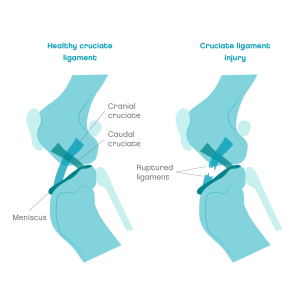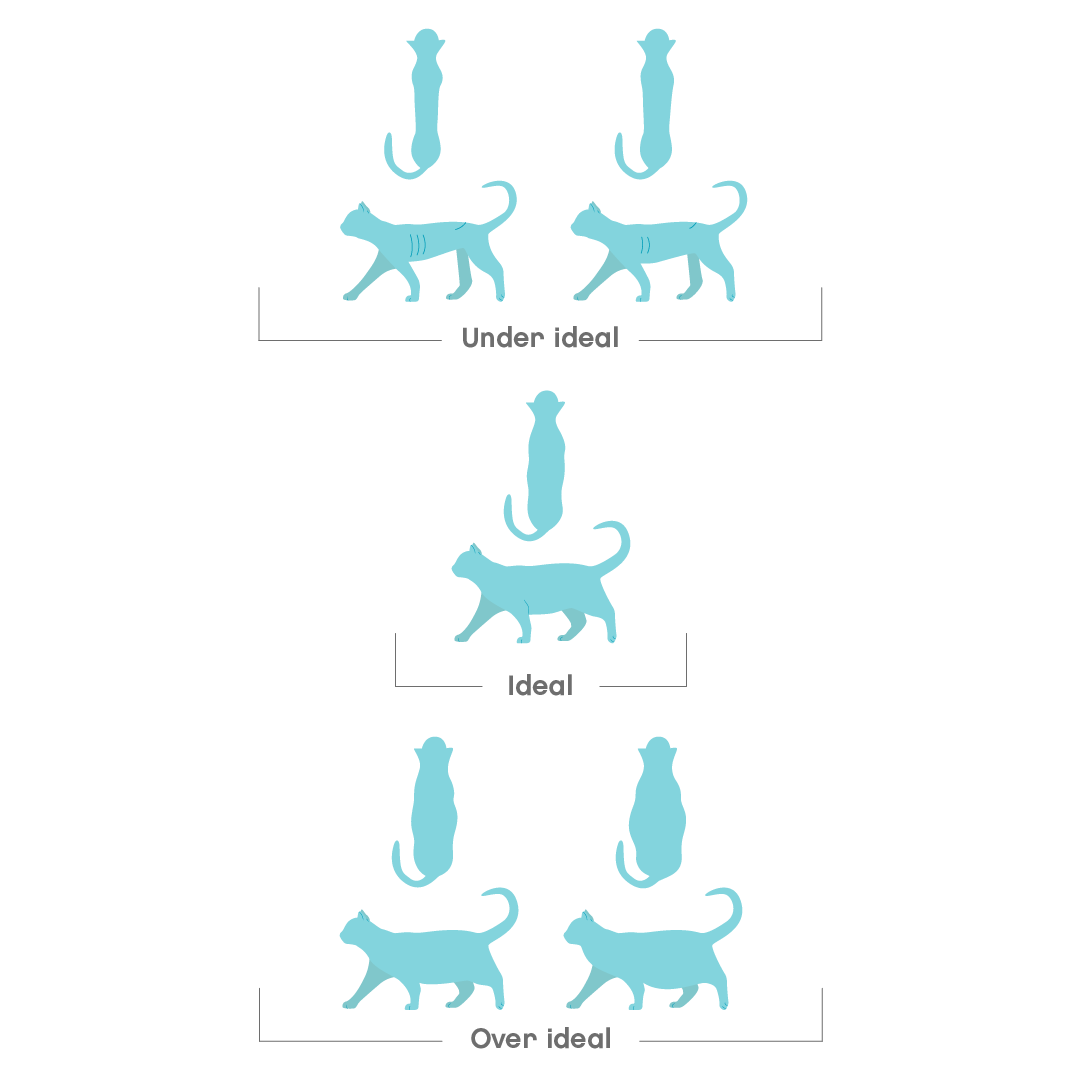Cruciate ligament disease affects fewer cats than dogs (only 12.2% of cases affect cats). It usually results in back leg lameness. Not all cases require surgery for treatment.
The most common form of knee ligament injury is the tearing of the cranial cruciate ligament (CrCL). In cats, it usually occurs as a result of trauma. This disease can also be called CrCL rupture, CrCL tear, anterior cruciate ligament (ACL) disease, or torn knee ligaments.
Overview
What is cruciate ligament disease in cats?
Your cat’s knee is a complex structure consisting of multiple bones: thigh bone (femur), kneecap (patella), shinbone (tibia), ligaments, and meniscus.
The cranial cruciate ligament (CrCL) is one of four ligaments that hold the knee joint together.

If the cruciate ligament is damaged, the knee becomes unstable and often very painful.
CrCL can tear partially or completely.
Cats are more likely to have other ligaments rupture alongside with CrCL.
Damage to the meniscus can occur in around 50% of cats that have CrCL rupture.
Limping is often the first sign to be identified.
Trauma is the most common cause, but inherited weak ligaments or obesity can cause cats to damage their cruciate ligaments too.
As a result of this condition, limb function will deteriorate if not treated, and arthritis will progress.
Symptoms
What are the signs of cruciate ligament disease in cats?
You might notice some or all of the following in your cat:
- Limping, that can start suddenly, worsen, persist, or become occasional
- A painful leg
- Reluctance to exercise or difficulty jumping and using the stairs
- Stiffness
- Change in behaviour: quieter than usual, hiding
People express pain and discomfort differently from pets, so although cats may not meow, cry out, or hold up their sore limb constantly, the persistence of their lameness is a sign of pain.
Risk
Are some cats more at risk of cruciate ligament disease?
Cruciate ligament disease is mostly seen in:
- Outdoor cats or highly exercised cats who suddenly jump or turn as they run. The ligaments are damaged by a twisting injury to the knee.
- Old age can weaken the ligaments.
- Obese cats can damage their ligaments due to the excess strain on the joints. Check your cat’s body score condition (BSC) to see if they are overweight.
Body Condition Scoring (BCS) in cats
Body Condition Score (BCS) is a scale that gives a practical evaluation of the fat coverage of your cat’s body. By checking how easy or not it is to feel certain bony areas of the body, a score is then produced. There are several scales, from 1 to 5 or 1 to 9. The ideal body condition lies in the middle, so either 3/5 or 5/9.
The body areas normally checked for fat coverage are:
1. ribs and spine
2. hips and shoulders
3. waist

Here are a few tips on how to do it.
With your pet in a standing position:
- Place your hands on the rib cage and gently feel for each rib, without pressing too hard
- Feel the waist and look from the top and the side (if you have a very furry breed, it may be harder to assess)
- Feel the spine, which runs down the middle of the back
- Feel the top of the hips and shoulders
Diagnosis
How do you diagnose cruciate ligament disease in cats?
Complete tears of the CrCL
Diagnosed by your vet using a combination of:
- Watching the way your cat walks
- Hands-on examination (including a special knee movement test, which is usually done under sedation)
- Radiographs (X-rays)
- Occasionally MRI
Partial CrCL tears
Can be more challenging to diagnose, requiring a visual inspection of the joint with:
- Exploratory surgery (open knee surgery)
- Arthroscopy (keyhole surgery with a camera on the joint)
This type of investigation may need to be conducted by a specialist vet in a referral hospital.
Vet treatment
Vet treatment for cats with cruciate ligament disease
There are two treatment options for CrCL disease: medical management and surgery.
Depending on the level of severity, your vet will offer the best option for your cat.
Medical management
Non-surgical treatment is, for many cats, the best option.
For best results, all of the following are recommended:
- Activity restriction for several weeks
- Anti-inflammatory and pain medication
- Weight management or weight loss
- Joint supplements to slow the progression of arthritis
- Rehabilitation and physiotherapy
Surgery
Surgery is usually recommended for more severe cases that have not responded to the above treatment.
These repairs involve the structures around the ligaments, not the ligaments themselves.
The surgery may need to be performed by a specialist vet at a referral hospital. Depending on your cat’s medical needs, the vet may recommend the following surgical techniques:
- Extracapsular suture stabilisation
- Tibial plateau leveling osteotomy (TPLO)
- Cranial closing wedge ostectomy (CWO)
- Tibial tuberosity advancement (TTA)
Home treatment
How to help your cat with cruciate ligament disease at home
Follow your vet’s recommendation and exercise restriction plan.
- Your vet’s plan will be very detailed for the first 6-8 weeks.
- Keep them calm using cage rest, leaving them in small rooms of the house with no access to high furniture.
- Keep their minds busy by feeding them in slow feeders and play mats
- Start physiotherapy as soon as possible and continue for the following 3 months. The protocol sessions will change as they reach different stages of treatment.
- A healthy weight is necessary both for the injured knee, as well as, to prevent the other knee from getting injured.
- Start them on a good joint supplement to slow the progression of arthritis.
- Lots of cuddles, love, and patience
Living with a cat with cruciate ligament disease
The progression of arthritis is likely
To slow the progression of the disease, we recommend starting your cat on a good joint supplement as well as doing some home modification to help your cat move easily.
See our arthritis article for more information.
Use the following links to find qualified physiotherapists
The Register of Animal Musculoskeletal Practitioners (RAMP),
The Association of Chartered Physiotherapists in Animal Therapy (ACPAT),
National Association of Veterinary Physiotherapists (NAVP)
Prevention
How to prevent your cat from developing cruciate ligament disease
It is difficult to prevent this condition. Maintaining a healthy weight is still important for obese cats, but this condition occurs mainly due to trauma while out and about or during playtime.
When to worry
When you should be worried about your cat with cruciate ligament disease
If your cat was diagnosed with CrCL disease, contact your local vet practice if they are:
- Not improving despite treatment
- Painful, swelling, or stiff in any joint
- Struggling to run, jump, or use the stairs
- Vomiting, diarrhoea, or loss of appetite (while medication has been prescribed)
Joii can help:
- If your cat had treatment for CrCL disease and you need tips to keep them calm and rested at home
- If your cat is having vomiting, diarrhoea, or loss of appetite (while medication has been prescribed)
- If you need help slowing the progression of arthritis
- Advice for weight management and feeding








